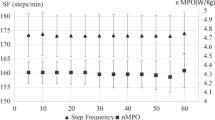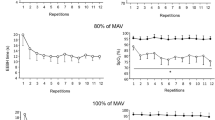Summary
A new maximal anaerobic running power (MARP) test was developed. It consisted ofn · 20-s runs on a treadmill with a 100-s recovery between the runs. During the first run the treadmill speed was 3.97 m · s−1 and the gradient 5°. The speed of the treadmill was increased by 0.35 m · s−1 for each consecutive run until exhaustion. The height of counter-movement jumps and blood lactate concentration ([1a−]b) were measured after each run. Submaximal ([la− ] b = 3 mmol · l−1 and 10 mmol · l−1) and maximal speed and power (\(\dot W_{3mmol} \),\(\dot W_{10mmol} \) and\(\dot W_{max} \), respectively) were calculated andW was expressed in oxygen equivalents according to the American College of Sports Medicine equation. Thirteen male athletes whose times over 400 m ranged from 47.98 s to 54.70 s served as subjects. In the MARP-test the speed at exhaustion was 6.89 (SD 0.28) m · s−1 corresponding to a\(\dot W_{max} \) of 118 (SD 5) ml · kg−1 · min−1. The peak [1a−]b after exhaustion was 17.0 (SD 1.6) mmol · l−1 . A significant correlation (r=0.89,P<0.001) was observed between the\(\dot W_{max} \) and the average speed in the 400-m sprint. The maximal 20-m sprinting speed on a track and\(\dot W_{10mmol} \) correlated with both the\(\dot W_{max} \) and the 400-m speed. It was concluded that the new method allows the evaluation of several determinants of maximal anaerobic performance including changes in the force-generating capacity of leg muscles and [la−]b relative to the speed of the sprint running. The [1a−]b at submaximal sprinting speed was suggested as describing the anaerobic sprinting economy.
Similar content being viewed by others
References
American College of Sports Medicine (1986) Guidelines for exercise testing and prescription. 3rd edn. Lea and Febiger, Philadelphia, p 168
Åstrand P-O, Rodahl K (1986) Textbook of work physiology. McGraw-Hill, Toronto, pp 295–329
Aunola S, Rusko H (1984) Reproducibility of aerobic and anaerobic thresholds in 20–50 year old men. Eur J Appl Physiol 53:260–266
Ayalon A, Inbar O, Bar-Or O (1974) Relationships among measurements of explosive strength and anaerobic power. In: Nelson RC, Morehouse CA (eds) International series on sports sciences, vol. 1. Biomechanics IV. University Park Press, Baltimore, pp 527–537
Bonen A, Campbell CJ, Kirby RL, Belcastro AN (1979) A multiple regression model for blood lactate removal in man. Pflügers Arch 380:205–210
Bosco C, Luhtanen P, Komi PV (1983) A simple method for measurement of mechanical power in jumping. Eur J Appl Physiol 50:273–282
Di Prampero PE (1981) Energetics of muscular exercise. Rev Physiol Biochem Pharmacol 89:143–222
Harris RC, Edwards RHT, Hultman E, Nordesjö L-O, Nylind B, Sahlin K (1976) The time course of phosphocreatine resynthesis during recovery of the quadriceps muscle in man. Pflügers Arch 367:137–142
Hermansen L (1971) Lactate production during exercise. In: Pernow B, Saltin B (eds) Muscle metabolism during exercise. Advances in experimental medicine and biology, vol. 11. Plenum Press, New York, pp 401–407
Hirvonen J, Rehunen S, Rusko H, Hörkönen M (1987) Breakdown of high energy phosphate compounds and lactate accumulation during short supramaximal exercise. Eur J Appl Physiol 56:253–259
Jansson E, Sylvén C, Nordevang E (1982) Myoglobin in the quadriceps femoris muscle of competitive cyclists and untrained men. Acta Physiol Scand 114:627–629
Jorfeldt L, Juhlin-Dannefelt A, Karlsson J (1978) Lactate release in relation to tissue lactate in human skeletal muscle during exercise. J Appl Physiol 44:350–352
Karlsson J, Nordesjö L-O, Jorfeldt L, Saltin B (1972) Muscle lactate, ATP, and CP levels during exercise after physical training in man. J Appl Physiol 33:199–203
Kindermann W, Simon G, Keul J (1979) The significance of the aerobic-anaerobic transition for the determination of work load intensities during endurance training. Eur J Appl Physiol 42:25–34
Komi PV, Bosco C (1978) Utilization of stored elastic energy in leg extensor muscles by men and women. Med Sci Sports 10:261–265
Mainwood GW, Renaud JM (1985) The effect of acid-base balance on fatigue of skeletal muscle. Can J Physiol Pharmacol 63:403–416
Margaria R, Aghemo P, Rovelli E (1966) Measurement of muscular power (anaerobic) in man. J Appl Physiol 21:1662–1664
Margaria R, Aghemo P, Sassi G (1971) Lactic acid production in supramaximal exercise. Pflügers Arch 326:152–161
Nummela A, Vuorimaa T, Rusko H (1992) Changes in force production, blood lactate and EMG activity in the 400 m sprint. J Sports Sci 10:217–228
Racine P, Klenk HO, Kochsiek K (1975) Rapid lactate determination with an electrochemical enzymatic sensor: clinical usability and comparative measurements. Z Klin Chem Klin Biochem 13:533–539
Rehunen S, Naveri H, Kuoppasalmi K, Härk:onen M (1982) Highenergy phosphate compounds during exercise in human slowtwitch and fast-twitch muscle fibres. Scand J Lab Invest 42:499–505
Saltin B, Essén B (1971) Muscle glycogen, lactate, ATP, and CP in intermittent exercise. In: Pernow B, Saltin B (eds) Muscle metabolism during exercise. Advances in experimental medicine and biology, vol. 11. Plenum Press, New York, pp 419–424
Schnabel A, Kindermann W (1983) Assessment of anaerobic capacity in runners. Eur J Appl Physiol 52:42–46
Szögy A, Cherebetiu G (1974) Minutentest auf dem Fahrradergometer zur Bestimmung der anaeroben Kapazität. Eur J Appl Physiol 33:171–176
Thomson JM, Garvie KJ (1981) A laboratory method for determination of anaerobic energy expenditure during sprinting. Can J Sports Sci 6:21–26
Vandewalle H, Pérès G, Monod H (1987) Standard anaerobic exercise tests. Sports Med 4:268–289
Author information
Authors and Affiliations
Rights and permissions
About this article
Cite this article
Rusko, H., Nummela, A. & Mero, A. A new method for the evaluation of anaerobic running power in athletes. Europ. J. Appl. Physiol. 66, 97–101 (1993). https://doi.org/10.1007/BF01427048
Accepted:
Issue Date:
DOI: https://doi.org/10.1007/BF01427048




